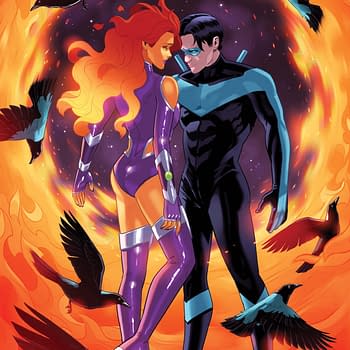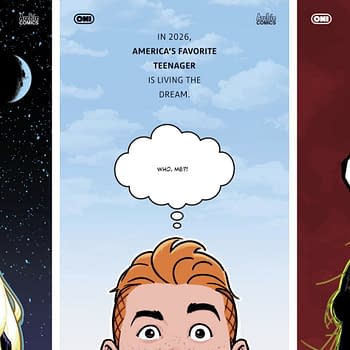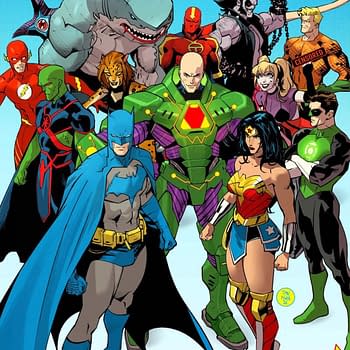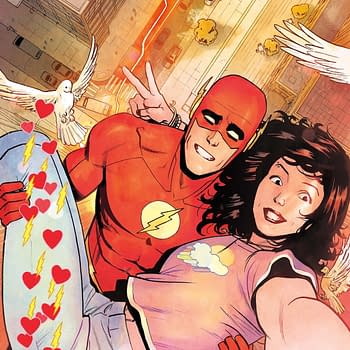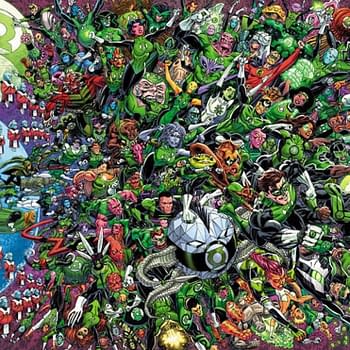Posted in: Comics | Tagged: Comics, dc, entertainment, gender, gendercrunching, marvel
Gendercrunching DC Comics 1996-2011 by Tim Hanley
Tim Hanley writes for Bleeding Cool;
It was a ridiculously busy but not particularly great month for either publisher, with their massive stacks of books not resulting in many female creators at all. DC slid down, while Marvel rose only slightly and remains firmly below their previous high.
DC COMICS
Hey, we've got a format change! We're going to run though the monthly totals quicker to get to some cool stuff in the third section. In August 2011, DC Comics released 97 new comic books with 861 credited creators, 768 male and 93 female. Here are all the charts at once:
If you miss the usual table, or are wondering what the raw numbers are, I'll gladly send them to you. So, 10.8% is below average for DC, and down 0.5% from last month. There was a lot of fill-in work this month (books with 4 or 5 inkers, for example) as DC tried to get everything out before the DCnU, but very few of those gigs went to women. There weren't a lot of huge swings this month… writers and pencillers went up slightly, while cover artists, inkers, letterers, and editors were all down by small amounts. Assistant editors gained a solid 3.9% from July, but colorists fell 3% and ended up in the single digits, which is odd for DC. Colorists are usually a strong category for them, but it's been slipping as of late… they were down nearly 5% last month. Overall, it was a sub-par month for DC… and if you're following the DCnU numbers, they're not exactly killing it in September either.
MARVEL COMICS
In August 2011, Marvel put out a whopping 100 new comics featuring 834 credited creators, 760 men and 74 women. Let's look at the charts, again all at once:
Marvel's 8.9% is a 0.1% gain from last month, marking the second month in a row that they've made the smallest increase possible. I'm glad to see them getting better, but this is a very slow climb. Numbers were up in nearly every category, though these gains were minimal as well. The biggest jump was pencillers, rising 1.6% from July… every other gain was by less than one percent. Letterers remained steady at zero, and inkers were the only group who dropped, falling 0.8%. I'll say this for Marvel's summer: They've been remarkably consistent. Overall, Marvel's still below their best, but they're slowly and steadily crawling up.
WOMEN AT DC COMICS, 1996-2011
This is why we just rushed through the regular numbers… for the next two months, we'll be looking at women in comics stats for the Big Two with some historical perspective, and seeing how things have changed in the industry over the past fifteen years.
The methodology for this project is pretty simple. Taking the stats I've compiled this year as a starting point, I've gone back in five year intervals three times, so now we have stats for 2006, 2001, and 1996. This gives us four data points for each publisher. I've tabulated two months of comics from each year (including 2011)… I chose January and July, because they're spaced six months apart and should give us a good sense of the year as a whole. And because if I did the entire year, it'd be 2014 before you ever saw the results. These two totals were added up and turned into percentages, and here we are.
Now, the key thing to remember with these numbers is that we are looking for trends. The exact numbers are, of course, fun and interesting, but the specifics are less important than the trends we're going to see in the chart.
We're going to do DC first, because with the DCnU in full swing, DC is all the rage. Plus, I figure that a month from now everyone is going to be REALLY sick of DC and glad for some Marvel information. The following is the percentages of female creators by category for each year… the full data for all of this is huge and I couldn't fit it in here even if I wanted to, but if you'd like to see the raw numbers, contact me and I'll send you the spreadsheets. So, the numbers:
This table is fun and all, but the important thing is trends, and they're far easier to see when you put the numbers in a chart:
Let's hit the main one first and talk about the overall total, the "All" category. Now, over the past 15 years, I think it's fair to say that the number of women who read comics has increased. Books like Y: The Last Man, Fables, and Alias have been good gateway books for guys to get their friends/girlfriends/wives/sisters/what have you into comics. People everywhere are noticing more women at comic book conventions and in comic book shops. But at DC Comics, the overall percentage of female creators has pretty much stayed the same. The very slight differences we see in the chart are statistically insignificant… that's as straight a line as you're going to get on a chart like this. Since 1996, the amount of women working at DC Comics has been stagnant. Things haven't changed at all in a decade and a half.
Another area of consistency is with artists. Pencillers have gone from two zeroes to some paltry representation, while inkers have stayed in the 2-3% range… both categories have been minimal for 15 years. DC hasn't done so great with lady artists.
Or lady colorists. So far this year, colorists have been the strongest creative category for DC every week, but they used to be even higher! I don't now why it dropped, but it dropped big. And letterers used to be a bit higher than they are now too.
I think the most significant drop, though, is with writers. It was a bigger drop for colorists, but colorists don't steer the direction of a book or get their names on the cover. Writers used to be a consistently solid category for DC, with totals ranging from 6 to 8.8% from 1996 to 2006. The drop to 2.7% in 2011 is quite a fall… in the big name categories, artists were never very strong for DC, but writers were. That they aren't now strikes me as odd… they seem to have dropped the ball there. Compared to past years, the creative side of things for DC isn't very good right now.
But editorial sure is… that is some impressive growth!! Editors rose steadily, while assistant editors seemed to jump all at once and claim a huge percentage. Nearly every week when I post the stats, I comment on how editorial is carrying DC's overall total, and here we can see that this is a fairly recent development. Things used to be spread out more, and for 1996 and 2001 it was colorists who had the highest total, but lately editorial's grown considerably. It's great to see that women are editing more books now and there's more of a female presence in DC's offices, but it's curious that this has been coupled with fewer women on the creative side.
When you look at things over time, you expect to see growth, particularly in terms of female representation. The role of women in American society has steadily improved over the past 40 years since the beginning of second wave feminism… for example, the number of women in Congress increased every year from 1979 on, until the most recent mid-term elections for the 2011 Congress. The wage gap between genders has been steadily closing for decades (though a sizeable gap still remains). At DC, we see growth in some areas, like editorial, but this is counteracted by declines elsewhere. All together, the percentage of female creators at DC Comics has been stagnant for 15 years, and I think that says a lot about the current state of the industry. They're not getting worse… they're not actively excluding women and becoming more of a boy's club. But they're not getting better, and that's disheartening. You stay the same by just not trying.
NOTES:
To learn more about this statistics project and its methodology click here, and to see the previous stats click here.
You can visit Tim at Straitened Circumstances and follow him on Twitter @timhanley01.










